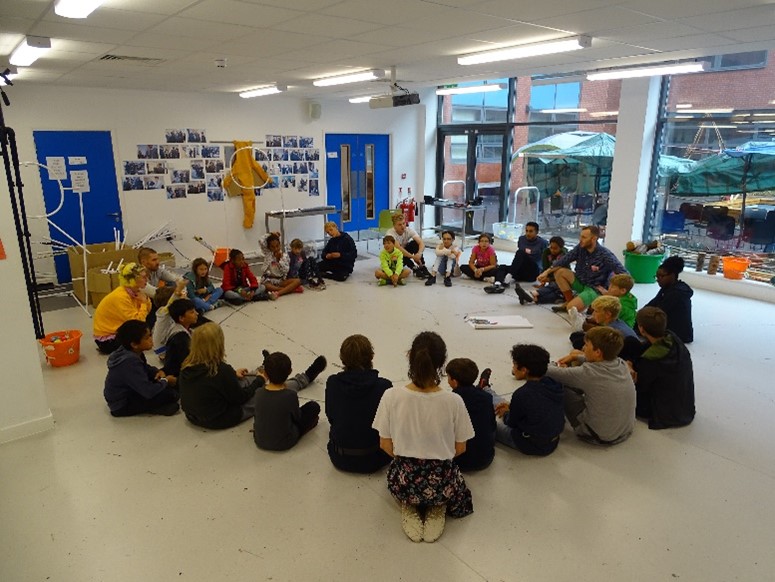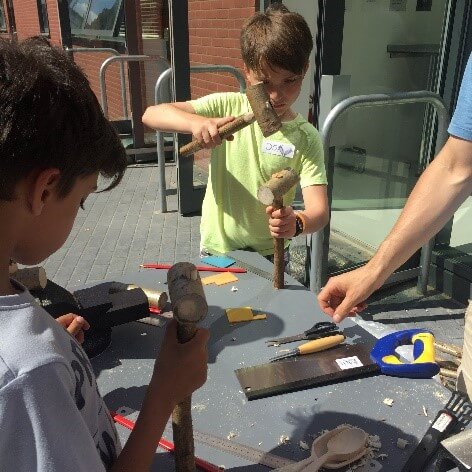Background
FixEd’s philosophy is to inspire the next generation of problem-solvers by supporting educators and organisations to engage and motivate learners through its programmes for schools and universities.
FixCamp was set up as a fun and inspiring way for children to learn, using cross-curricular conversations, a connection with 21st century technology, and ideas grounded in innovation and social impact. The project took subjects out of the classroom and used a creative approach to problem-solving and practical making skills to encourage children to engage in the world around them.
As a public engagement activity, the project allowed engineers and related practitioners to demonstrate the importance of making and prototyping, and gave them first-hand experience of working with children and young people in inspiring educational activities.
Changing the world with imagination
FixCamp was targeted at young people aged 9 to 14 and their families from Brixton and the surrounding area. Each day FixCamp dealt with a different overarching challenge drawn from UN Sustainable Development Goal (SDG) 11, which relates to cities and communities. These challenges ranged from specific problems, such as housing and transport, to relatively abstract ones, like living together.
For FixEd founder Dee Halligan, focusing the activities on SDG 11 allowed all the children to relate to the challenges and activities they were taking part in.
“We looked at SDG 11 and we felt that worked for us across a number of our needs. In particular, the children who are walking through the doors come from all different types of backgrounds but they all live in a city so they’re all familiar with the issues of cities: they can relate and have ideas about how can we change them for the better, so we’re applying their imagination to their own world”
Dee Halligan, Co-founder and Managing Director, FixEd

FixCamp work begins
Held for the first time at South Bank Engineering UTC in Brixton during the summer of 2018,
FixCamp prototyped a hands-on experience for young people, encouraging creative and critical exploration of new ideas and technologies through discussion, teamwork and large-scale making.
FixCamp ran for 15 days, with young people attending for a minimum of two days. Each day’s activity was completed on the same day, so returning children cycled through groups focused on specific materials and skills.
Each day began with campers making their own tool belts, using a range of natural and synthetic materials. This was followed by two structured morning sessions on making tools and learning skills. Children carried out tasks including whittling a mallet, 3D printing a screwdriver and wiring a plug.
The afternoon sessions focused on the daily SDG 11 challenges. An engineer supported a group discussion that explored big ideas. The campers broke into teams to sketch ideas, then prototype, build and present back to the group. The resulting 62 ‘big builds’ were physically and intellectually ambitious, investigating the future of housing, education, transport, and many more issues.
Two heads of camp and five activity leaders ran the camps, supported by one or two daily volunteers – runners and coaches. Runners assisted in daily activities and provided support where needed. Expert engineer coaches supported the afternoon sessions, encouraging young people to develop their ideas and demonstrating the diverse nature of engineering. The team was diverse in terms of gender, (62% male, 38% female); ethnicity (67% white, 10% Asian and Black, 14% Black) and disciplinary background. Although predominantly engineers by background, including a recent student at an engineering college and a retired engineer specialising in electrical and transport engineering, the team included an architect and two designers.
FixCamp received 265 bookings from 48 schools. Having targeted four types of under-served audiences – girls, people from Black, Asian and minority ethnic (BAME) backgrounds, people from low-income backgrounds, and families with perceived barriers to the creative industry –FixCamp had a 33% female to male ratio, 29% of children came from BAME groups and 18% of places were for families from lower-income backgrounds.
Experimenting with engineers
As the project required engineers to be available for three weeks in the summer, the team targeted students, as well as volunteers from the STEM Ambassador Hub. They combined prototyping and recruitment sessions to solve the challenge of recruiting and training a lot of people at the same time. Applications came primarily from engineers and technologists, as well as designers and artists who were working with technology. Applicants were put into teams at the recruitment sessions to test the activities that were being planned for the camp itself.
Creating an impact
Campers marked their experience as 9.5/10. The positive feedback from both children and parents showed their support for engagement that works with a combination of traditional and new materials and technologies. The challenge themes were popular and resonant, inspiring forward-thinking and ingenious ideas from the children, and all engineers working on the project praised this approach.
26 campers said they wanted to be engineers when they grow up
85% of the engineers who took part said they would like to volunteer at anotherFixCamp
85% of the engineers said that they had developed their communication skills
70% of the engineers said that they had a better understanding of working with children after their experience atFixCamp
“I am increasingly confident in talking about my work, in particular in knowing how to adjust the level of information and technical detail when talking to children of varying ages”
Engineer
There were also positive responses from parents:
“He loved it. You have all created something brilliant. Thank you. I wish school could be like this for them all. He has had a tough year, he’s dyslexic and confidence shaky so especially good ”
Parent

Three tips for building an audience for an Ingenious project
- Get to know the local community
The FixEd team knew that to attract their audience to FixCamp they needed to ensure the project was accessible to the local community. Having designed the project to be relevant to the local Brixton community, with the children’s lived experience at the heart of their activities, the challenge was to take the project to the target audience. An early decision was to include a discount for people from postcodes within the local area. Other key accessibility considerations for the team were how many days they were expecting children to attend, keeping in mind different types of families having varying needs, timings of the days and sessions, the pricing, and the location. The team chose a local school as the best location for FixCamp.
“It would have been possible for us to run this in a museum, we would have been able to locate it in a university, but we thought by locating it in a school there’s something very normal about that, so you don’t have any barrier of people thinking that place is not for me”
Dee Halligan
- Keep an open mind on marketing channels
Local connections were fundamental to linking up with the community and were just as useful as online forums and social media. The teams spent several trips cycling up and down Brixton Hill leaving flyers in all kinds of spaces such as restaurants and local noticeboards. Fixcamp also caught the eye of the local press, with Brixton Buzz featuring the project in the paper and on its website.
- Stay calm and persevere
After all their hard work to get the word out, there were some early nerves for the team, who felt the splash they had made with local press coverage and social media was not reflected in bookings. Having completely booked out the first week, there were fewer bookings for weeks two and three. However, once the children came along for their first day, they enjoyed it so much that many wanted to come back for more. FixCamp received 30 repeat bookings and people also told their friends.
The future of FixCamp
The FixEd team developed FixCamp as a prototype that could be adapted for a variety of audiences, and they received several approaches from organisations interested in running their own event. The team is currently supporting the Museum of Making in Derby, advising on a sequence of workshops and designing a FixCamp that reflects Derby’s industrial heritage, adapting the template to suit a very different context.
“We considered it as a demonstration project, or a prototype, something new outside of what we were doing already. It expanded our world, it crystallised some of the ways we’d been thinking about working but weren’t proven to us. We work in small-scale and this allowed us to take it all a little further and start to combine it around our values, around access and inclusion, and that was really key for us”
Dee Halligan
